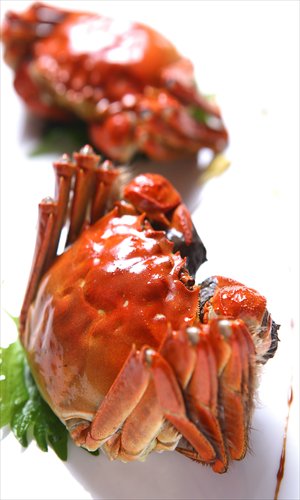As autumn leaves ...
Editor's note
The ancient Chinese created an agricultural solar system - still in use today - that is based upon their observation of crops, climate, astrology, and the study of animal and plant life cycles. The system guided farmers as to when to sow seeds and when to harvest them, and this system has now been in place for more than 2,000 years.
Today, with advances in science and technology, agriculture depends less on this ancient wisdom. But this seasonal calendar still operates as a reference guide for gourmands to seek out the best times for seasonal delicacies and for health experts to plan nutritious diets.
In a single year, the system features 24 "solar terms," each lasting one day and occurring every two weeks. Each has its own name and characteristics. The Global Times is presenting a weekly series examining which foods and delicacies are best enjoyed during these periods, as well as tips on preserving general health.

Shuangjiang, which in English means "frost's descent," is the 18th solar term of the year, and the last one in autumn. Falling on October 24 this year (it can also occur on October 23), shuangjiang ushers in the beginning of winter as the climate gets considerably cooler.
During this period, frost also begins to appear along the Yellow River valley, where farmers are busy planting wheat and barley. The maple leaves on mountainsides also turn a deep red color creating the beautiful scenic landscapes typical of late fall.
Fresh ingredients
According to traditional Chinese medicine (TCM), people should be cautious about preventing their spleen and stomach from becoming too cold. People often suffer recurrences of cardiovascular disease and chronic gastritis during this period. So it's advisable to choose dishes with fresh ingredients in order to nourish your body's yin qualities and to hydrate the lungs.
As a famous Chinese saying has it, "Even eating well all year round is not as good as nourishing the body on the first day of shuangjiang." The Global Times has found two simple, but tasty, recipes to help nourish the body during this solar period.
Steamed hairy crabs
Hairy crab tops the gourmets' most-wanted list in autumn, especially at the height of the crab's maturity during September and October.
Besides various fancy dishes made with hairy crab - including crab in wine sauce, in rapeseed oil and salt, or stir-fried crab roe - the most popular dish for expats and locals alike is steamed hairy crab. Cooked this way it maintains all its fresh flavor and tenderness, and is easy for novice chefs to prepare.
Ingredients:
Four robust crabs, three tablespoons sugar, 10 pieces sliced ginger, one cup vinegar
Method:
* Cover the hairy crabs in clean water for half a day to loosen all the sand and mud from inside
* Clean the crabs with a toothbrush, especially their pincers where mud can hide, before cooking
* Boil a pot of hot water, add five slices of ginger, and put the hairy crabs on a steam rack for 10 to 15 minutes
*Mix the vinegar and sugar together, and put on a medium heat until they are well blended
* Mince the remaining five slices of ginger, and add into the vinegar and ginger sauce
* Hairy crabs are ready to serve together with the sauce
Because hairy crabs have a "cold" or yin character, the use of a large amount of ginger (which has a "warm" or yang character) helps balance these two elements in the body.
The success of a steamed dish mostly relies on the freshness of ingredients. Here are some tips about how to pick the ideal hairy crab. Firstly a robust crab should be very responsive to stimulation; if you touch its eyes, it should fight back with its pincers. If you turn a crab upside down, a fresh, healthy crab should be able to turn itself upright again fairly quickly. Also pay attention to their outward appearance - bluish-tinged crabs with hard shells are the best. And naturally, heavier crabs will contain more meat.
Stewed duck soup with taro and gingko nuts
In Fujian Province, people use to cook duck with taro on the day of shuangjiang. It is said that taro is at its most nutritious during this time, and duck is also at its juiciest and plumpest.
Gingko nuts, a symbol of autumn, also mature in October, a time when coughs, asthma and bronchitis can easily reoccur given the worsening weather. But people should pay careful attention to the amount they eat, because over consumption can lead to symptoms that resemble food poisoning such as diarrhea.
After several hours simmering, the duck meat will turn salty with a savory tenderness. The taro becomes soft and glutinous with a sweet taste, and the soup turns white, thick and tasty.
Ingredients:
A clean duck about 1,000 grams in weight, 250 grams taro and 10 gingko nuts, five sliced ginger, three tablespoons of Chinese rice wine, two chopped spring onions, two tablespoons cooking oil, salt to taste
Method:
* Wash the duck, chop it into chunky pieces and remove any excessive fat if necessary
* Cook the taro until it's soft (when you can pierce it right through with a chopstick), peel off the skin of the taro and chop into chunks
* Heat up a pot with two tablespoons of cooking oil, add the slices of ginger and the chopped spring onions
* Add the duck pieces and stir-fry on a medium heat until both sides are slightly golden; then pour in the Chinese rice wine
* Add water to cover the duck chunks, bring to the boil and then simmer over a high heat for 15 minutes until the soup turns into milky-white
* Simmer on a low heat for two hours, add the taro and gingko nut, and cook for 30 more minutes
* Season the soup with salt and serve hot